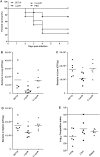The CpxR regulates type VI secretion system 2 expression and facilitates the interbacterial competition activity and virulence of avian pathogenic Escherichia coli
- PMID: 31126325
- PMCID: PMC6534853
- DOI: 10.1186/s13567-019-0658-7
The CpxR regulates type VI secretion system 2 expression and facilitates the interbacterial competition activity and virulence of avian pathogenic Escherichia coli
Abstract
Systemic infections caused by avian pathogenic Escherichia coli (APEC) are economically devastating to poultry industries worldwide and are also potentially threatening to human health. Pathogens must be able to precisely modulate gene expression to facilitate their survival and the successful infection. The Cpx two-component signal transduction system (TCS) regulates surface structure assembly and virulence factors implicated in Gram-negative bacterial pathogenesis. However, the roles of the Cpx TCS in bacterial fitness and pathogenesis during APEC infection are not completely understood. Here, we show that the Cpx TCS response regulator CpxR is critical to the survival and virulence of APEC. Inactivation of cpxR leads to significant defects in the interbacterial competition activity, invasion and survival of APEC in vitro and in vivo. Moreover, activation of CpxR positive regulates the expression of the APEC type VI secretion system 2 (T6SS2). Further investigations revealed that phosphorylated CpxR directly bound to the T6SS2 hcp2B promoter region. Taken together, our results demonstrated that CpxR contributes to the pathogensis of APEC at least through directly regulating the expression and function of T6SS2. This study broadens understanding of the regulatory effect of Cpx TCS, thus elucidating the mechanisms through which Cpx TCS involved in bacterial virulence.
Conflict of interest statement
The authors declare that they have no competing interests.
Figures






References
-
- Ewers C, Li G, Wilking H, Kiessling S, Alt K, Antao EM, Laturnus C, Diehl I, Glodde S, Homeier T, Bohnke U, Steinruck H, Philipp HC, Wieler LH. Avian pathogenic, uropathogenic, and newborn meningitis-causing Escherichia coli: how closely related are they? Int J Med Microbiol. 2007;297:163–176. doi: 10.1016/j.ijmm.2007.01.003. - DOI - PubMed
-
- Tivendale KA, Logue CM, Kariyawasam S, Jordan D, Hussein A, Li G, Wannemuehler Y, Nolan LK. Avian-pathogenic Escherichia coli strains are similar to neonatal meningitis E. coli strains and are able to cause meningitis in the rat model of human disease. Infect Immun. 2010;78:3412–3419. doi: 10.1128/IAI.00347-10. - DOI - PMC - PubMed
-
- Moulin-Schouleur M, Reperant M, Laurent S, Bree A, Mignon-Grasteau S, Germon P, Rasschaert D, Schouler C. Extraintestinal pathogenic Escherichia coli strains of avian and human origin: link between phylogenetic relationships and common virulence patterns. J Clin Microbiol. 2007;45:3366–3376. doi: 10.1128/JCM.00037-07. - DOI - PMC - PubMed
-
- Bauchart P, Germon P, Bree A, Oswald E, Hacker J, Dobrindt U. Pathogenomic comparison of human extraintestinal and avian pathogenic Escherichia coli—search for factors involved in host specificity or zoonotic potential. Microb Pathog. 2010;49:105–115. doi: 10.1016/j.micpath.2010.05.004. - DOI - PubMed
-
- Rendon MA, Saldana Z, Erdem AL, Monteiro-Neto V, Vazquez A, Kaper JB, Puente JL, Giron JA. Commensal and pathogenic Escherichia coli use a common pilus adherence factor for epithelial cell colonization. Proc Natl Acad Sci U S A. 2007;104:10637–10642. doi: 10.1073/pnas.0704104104. - DOI - PMC - PubMed
MeSH terms
Substances
Grants and funding
LinkOut - more resources
Full Text Sources
Medical
Molecular Biology Databases

